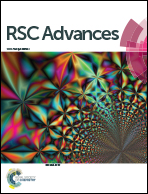Novel catalyst PTMA-PILC: structural properties and catalytic performance for the dehydration of bioethanol to ethylene†
Abstract
Novel phosphomolybdic acid-pillared interlayer clay (PTMA-PILC) catalysts were prepared by three steps: acid treatment, ion-exchange and impregnation method. The resulting catalysts were initially characterized by a combination of XRD analysis, FT-IR, TG, NH3-TPD, pyridine-IR, TEM, and N2 adsorption–desorption. The characterization results indicated that the sandwich structure of the montmorillonite was delaminated on acid treatment, resulting in a reduction of the surface area to 335 m2 g−1 and the formation of plate-like particles. Surprisingly, after ion-exchange and impregnation, the stratified structure was restored. The strong and weak acidity contents also changed. The catalytic properties of this series of catalysts were tested in the dehydration of ethanol to ethylene. A significant improvement in catalytic activity was observed in the dehydration of ethanol (30 vol%) to ethylene on the synthesized PTMA-PILC catalyst, from which 93.2% conversion and 99.1% selectivity of ethylene were achieved at 300 °C. The improved activities were attributed to the layer structure and the balance of Lewis and Brønsted acid sites.



 Please wait while we load your content...
Please wait while we load your content...